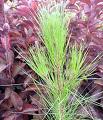Cuban Pine Tree Information
Images of Cuban Pine:






Cuban Pine grows in the following 13 states and provinces:
Alabama, Arkansas, Florida, Georgia, Kentucky, Louisiana, Mississippi, North Carolina, Oklahoma, South Carolina, Tennessee, Texas, VirginiaInformation about Cuban Pine:
The Pinus Elliottii is commonly known as the Cuban Pine, Dade County Pine, Dade County Slash Pine, Pitch Pine, Slash Pine, South Florida Slash Pine, Swamp Pine as well as Yellow Slash Pine.
The currently accepted scientific name of slash pine is Pinus elliottii Engelm. . The species is divided into two geographic varieties: Pinus elliottii var. elliottii Pinus elliottii var. densa Little & Dorman = south Florida slash pine There is a transitional zone where morphological traits of the two varieties show clinal variation. Both varieties will be discussed in this report with emphasis on the typical slash pine variety, P. elliottii var. elliottii. Slash pine occasionally hybridizes with loblolly pine (P. taeda), late flowering sand pine (P. clausa), and early flowering longleaf pine (P. palustris) .The native range of the typical slash pine variety includes the Coastal Plain from southern South Carolina to central Florida and west to eastern Louisiana. Slash pine has been planted as far north as Kentucky and Virginia , and as far west as eastern Texas, where it now reproduces naturally . The south Florida variety occurs in central and southern Florida and in the lower Florida Keys .The published classifications listing slash pine as dominant in community types (cts) are presented below: Area Classification Authority SC general veg. cts Nelson 1986 se US: Gulf Coast gereral forest cts Pessin 1933 se US general forest cts Waggoner 1975 se US general veg. cts Christensen 1988 nc FL general forest cts Monk 1968 Some of the information provided here is attributed to:Carey, Jennifer H. 1992. Pinus elliottii. In: Fire Effects Information System, [Online]. U.S. Department of Agriculture, Forest Service, Rocky Mountain Research Station, Fire Sciences Laboratory (Producer). , available at the USDA Fire Effects Information System (FEIS) website